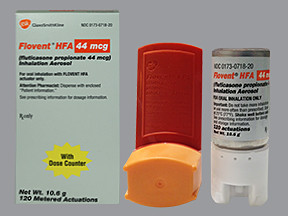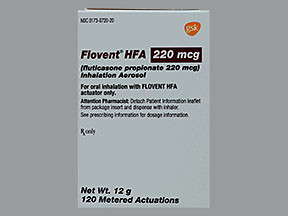FLUTICASONE HFA INHALER - ORAL
PHONETIC PRONUNCIATION: (floo-TIK-a-sone)
COMMON BRAND NAME(S): Flovent HFA
GENERIC NAME(S): fluticasone propionate
Uses
USES: Fluticasone is used to control and prevent symptoms (such as wheezing and shortness of breath) caused by asthma. It works by reducing swelling (inflammation) of the airways in the lungs to make breathing easier. Controlling symptoms of asthma helps you maintain your normal activities and decreases time lost from work or school. Fluticasone belongs to a class of drugs known as corticosteroids. This medication must be used regularly to be effective. It does not work right away and should not be used to relieve sudden asthma attacks. If an asthma attack occurs, use your quick-relief inhaler (such as albuterol, also called salbutamol in some countries) as prescribed.
How to use FLUTICASONE HFA INHALER - ORAL
HOW TO USE: Read the Patient Information Leaflet that comes with this product before you start using fluticasone and each time you get a refill. Read the patient instructions on how to use this inhaler properly. If you have any questions, ask your doctor or pharmacist. Follow the instructions for priming the inhaler if you are using it for the first time, if you have not used it for more than 1 week, or if you dropped the inhaler. When priming the inhaler, make sure to spray away from your face so that you do not get the medication into your eyes. Shake the inhaler well for 5 seconds before each use. Inhale this medication by mouth as directed by your doctor, usually twice a day (in the morning and evening). The dosage is based on your medical condition and response to treatment. Talk to your doctor or pharmacist if you have trouble using this inhaler. Young children may get better results using a spacer device and face mask with this medication. If two inhalations/puffs are prescribed, wait about 30 seconds between them. Shake the inhaler well between each puff. If you are using other inhalers at the same time, wait at least 1 minute between the use of each medication, and use this drug (the corticosteroid) last. Gargle and rinse your mouth with water after each use to help prevent irritation and fungal/yeast infections (thrush) in the mouth and throat. Do not swallow the rinse water. Use this medication regularly to get the most benefit from it. This medication works best if used at evenly spaced intervals. To help you remember, use it at the same times each day. Do not increase your dose, use this medication more often, or stop using it without first consulting your doctor. If you are regularly using a different corticosteroid taken by mouth (such as prednisone), you should not stop using it unless directed by your doctor. You may have withdrawal symptoms if the drug is suddenly stopped. Some conditions (such as asthma, allergies) may become worse when the drug is suddenly stopped. To prevent withdrawal symptoms (such as weakness, weight loss, nausea, muscle pain, headache, tiredness, dizziness), your doctor may direct you to slowly lower the dose of your old medication after you begin using this product. Consult your doctor or pharmacist for more details, and report any withdrawal reactions right away. See also Precautions section. Clean the inhaler regularly as directed. Keep track of the number of inhalations used. Discard the canister after using the labeled number of inhalations on the package, even if it feels as though there is medication left in the canister. It may take up to 2 weeks or longer before the full benefit of this drug takes effect. Tell your doctor if your condition does not improve or if it worsens. Learn which of your inhalers you should use every day (controller drugs) and which you should use if your breathing suddenly worsens (quick-relief drugs). Ask your doctor ahead of time what you should do if you have new or worsening cough or shortness of breath, wheezing, increased sputum, worsening peak flow meter readings, waking up at night with trouble breathing, if you use your quick-relief inhaler more often (more than 2 days a week), or if your quick-relief inhaler does not seem to be working well. Learn when you can treat sudden breathing problems by yourself and when you must get medical help right away.
Side Effects
Precautions
Interactions
Overdose
Images
Reviews
Faq for FLUTICASONE HFA INHALER - ORAL
Fluticasone HFA inhaler is used to treat asthma, including the prevention of asthma attacks. It is also used for the treatment of chronic obstructive pulmonary disease (COPD) and other breathing disorders.
Fluticasone HFA inhaler belongs to a class of medications called corticosteroids. It works by reducing inflammation and swelling in the airways, allowing for easier breathing.
It is important to follow the instructions provided by your healthcare provider. Typically, you should shake the inhaler well before each use and inhale the prescribed dose by mouth. Be sure to rinse your mouth with water and spit it out after each use to prevent the risk of fungal infections.
Common side effects of fluticasone HFA inhaler include headache, throat irritation, cough, and hoarseness. Rare but serious side effects may include allergic reactions, difficulty breathing, and changes in vision. Contact your doctor if you experience any severe or persistent side effects.
Fluticasone HFA inhaler may interact with some medications, such as ritonavir, ketoconazole, and certain other steroids. It is important to inform your doctor about all the medications you are taking, including over-the-counter drugs and herbal supplements, to avoid potential interactions.
The effects of fluticasone HFA inhaler may vary from person to person. In general, it may take a few days to weeks for the medication to reach its full effectiveness. You should continue using it regularly as prescribed by your doctor, even if you do not notice immediate improvement.
Disclaimer
IMPORTANT: HOW TO USE THIS INFORMATION: This is a summary and does NOT have all possible information about this product. This information does not assure that this product is safe, effective, or appropriate for you. This information is not individual medical advice and does not substitute for the advice of your health care professional. Always ask your health care professional for complete information about this product and your specific health needs.



No Reviews Yet